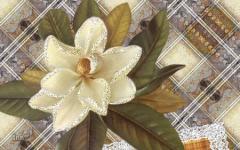Orchid- an exotic highly decorative flower, a representative of the Orchid family. The plant belongs to one of the most ancient families, which appeared in the late Cretaceous era.
The first orchids appeared on Earth over 130 million years ago.
Orchids are one of the most popular flowering plants and are important greenhouse flowers. At home, you can grow only a few varieties. Astrologers say that this amazing flower has a beneficial effect on the atmosphere in the house. It will be useful for people who easily get depressed. Delicate orchid petals reflect the purity and beauty of the soul. Orchids are very fragile and delicate plants that need constant care, otherwise they will die. But, even being very vulnerable, flowers affect the mood of a person and his peace of mind. An orchid in the house will inspire creativity, devoid of self-interest. A white orchid is perfect as a gift for an artist or musician, if he is inclined to see the world in minor tones. yellow orchids will inspire creativity for the sake of creativity, because they are controlled by the Sun itself. Scarlet orchids will stimulate their owner to constant work, these are passionate, impulsive flowers, they will be a godsend for a lazy person. Pink orchids are created for people who dream that their works will win hearts.
Thanks to this treatment, the orchid should release new shoots of flowers and bloom again. After flowering in autumn, we limit watering and move the plant to a lower temperature, after a few months of rest, in spring, we move this bright room again and we start watering and fertilizing. We usually grow orchids in a mixture of bark and any fibrous substrate. It is important to be extremely permeable.
We only transplant a plant when it is no longer in a pot, like a small one, to a tight pot. Often, but extremely sparingly, not allowing water to remain at the bottom of the dish. The orchid can be watered by spraying the soil with a sprinkler or by spraying the flower pot in water and after removing it to give it an outlet.
 botanical name"Orchid" according to scientists comes from the Greek word "orchis" - "testicle" and is associated with the shape of the rhizome. The flower is considered a symbol of love and rebirth. In Asia, it is customary to weave these flowers into braids for girls. In Europe, orchids appeared not so long ago. Of course, from the stories of sailors, Europeans had heard about an amazing flower, but it was impossible to deliver it across the ocean. Flowers died in huge numbers, England even began to be called the "grave of orchids." The first living flower was delivered in 1793 from the Bahamas. The long-awaited flower literally stunned with its beauty, so in the 18th century there was a real flower boom. Whole expeditions to the uninhabited forests of Africa and South America were organized to collect orchids. Many people died from diseases, were attacked by animals or died as a result of accidents, but this did not stop the brave orchid hunters, because they knew that this flower promises them a fortune.
botanical name"Orchid" according to scientists comes from the Greek word "orchis" - "testicle" and is associated with the shape of the rhizome. The flower is considered a symbol of love and rebirth. In Asia, it is customary to weave these flowers into braids for girls. In Europe, orchids appeared not so long ago. Of course, from the stories of sailors, Europeans had heard about an amazing flower, but it was impossible to deliver it across the ocean. Flowers died in huge numbers, England even began to be called the "grave of orchids." The first living flower was delivered in 1793 from the Bahamas. The long-awaited flower literally stunned with its beauty, so in the 18th century there was a real flower boom. Whole expeditions to the uninhabited forests of Africa and South America were organized to collect orchids. Many people died from diseases, were attacked by animals or died as a result of accidents, but this did not stop the brave orchid hunters, because they knew that this flower promises them a fortune.
You will soon find many new gardening products. Department - garden design and in it, how to design a garden, a pond, garden projects and the creation of gardens. The ranch is our gardens, and it has gardens, gardening and gardening, gardens, gardens. This is one of the most popular flowers in the world. An orchid is a wonderful gift that grabs the attention of everyone around you in any situation. The significance of orchids makes them such special gifts for various occasions such as birthdays, thanksgiving, Greeting Cards etc.
Orchids are classified according to physical characteristics, including flower color, leaf shape, stem height and growth mode. The beauty and delicacy of orchids have attracted people of many generations. The orchid family is a diverse group of plant species classified according to different types, depending on the external and internal characteristics. Most of these plants are found in the tropical regions of Central and South America and Asia.
Growing: planting and care

You can grow an orchid at home. Orchids grow well next to moisture-loving plants: violets, arrowroot, philodendron. Of course, in the wild, flowers feel great on tree branches, but in room conditions orchid can be grown in flower pot. The roots must be surrounded by a moist substrate, from which the plant will receive all the nutrients it needs. Plastic pots are suitable for orchids, not clay pots. At the bottom of the peas there should be holes for water to drain: this will help get rid of excess moisture, and the roots will also be well ventilated from below. Soil also plays an important role. The soil and pot should support the plant in an upright position, and also retain maximum moisture, while passing air well.
Trees with these vibrant colors and their physical traits vary from one species to another. Depending on the growing needs, orchids are divided into 3 categories. Terrestrial - growing on the ground, in temperate and cold regions, epiphytic - grow on trees, in tropical lithophytic regions - grow on stones or in very poor soils in nutrients. The most common types of orchids are.
Flowers grow from the smell of pseudobulbs and cinnamon. Hybrids are produced by combining two different types, a total of 9 species of Anguloa. They grow in the forest regions of Peru, Ecuador, Colombia and Venezuela. The flowers resemble tulips, which is why tulips are called orchids. Dendrobium is one of largest species orchids, with many species. It is a type of white orchid and is known as an "orchid" restaurant. "The hybrids produce pink, green, yellow and purple flowers." "They are usually used during wedding seasons and festivals for decorative purposes." The leaves are oval. This epiphyte plant grows well throughout Australia, Guinea, China, New Zealand, etc.
Orchid soil should not contain earth: only bark, natural fibers, coal, moss, cork, sand.
In order to grow this exotic beauty, you should take care of the lighting. The plant needs to provide a lot of diffused light. You can recognize the lack of lighting by the plant itself, because in this case it will stop flowering, and its leaves become light green and soon turn yellow. Direct sunlight can cause leaf burn on a tender plant, so the orchid should be covered with a film. If the daylight hours of an orchid is less than 10 hours a day, at a rate of 12 hours a day, artificial lighting will have to be installed. The temperature regime depends on the type of plants, it can be heat-loving orchids, medium heat-loving and cold-loving. In order to determine the type of plant, use a little hint: all orchids purchased in a flower shop will grow well at daytime temperatures of +18 - +27 and at night temperatures of +13 - +24.
They produce pink purple flowers that are lightly sold in gardening stores and beyond. They are offered as gifts for loved ones and are also kept as living plants. The Phalaenopsis sprouts or the moon orchid develops wonderful white flowers. Butterfly orchids are found mainly in Asia. They look superbly decorated in vases. Another interesting thing: Orchid boat is used for culinary purposes in Bhutan. This orchid took on polarity in Europe during the Victorian era.
Milt, also known as Miltonia, appears mainly in Brazil, Paraguay, and Argentina. This is a type of orchid used for horticultural purposes in Central America. It is an epiphyte orchid that produces waxed flowers. The flowers have exotic scents and can be kept in the home to create a soothing atmosphere. Flowers exist in various colors which makes them so adaptable and adorable. This is one of the essential factors necessary for the growth of these plants. Conditions vary by species.

An important factor plant development is regular watering. In their natural habitat, flowers are not subject to prolonged stagnation of moisture. Therefore, at home, the flower needs to create all conditions close to its habitats. Watering must be taken seriously: with insufficient watering, yellowness will form on the leaves, but with excessive watering there is a possibility of root rot. The flower should be watered with settled rainwater, but boiled tap water is also suitable. The flower pot is immersed in water for 5 minutes, and then removed to drain excess moisture.
The name comes from ancient Greece and is associated with a long history that involved lust, greed and wealth. Orchids are the most delicate and exotic flowers in the world and are available in several varieties. in the country, with different meanings depending on the types of orchids.
It is a symbol of love and affection. It has the ability to grow anywhere and the power to thrive in any condition. According to Victorian era, the orchid symbolizes beautiful woman. Orchids were also associated with luxury and wealth, and in ancient Greece, the orchid was considered a symbol of masculinity. Later, orchids were used to treat diseases.
Feed the plant with fertilizer, it can be bought at a flower shop. As a fertilizer, you can use beer diluted 70% with water, you can also feed orchids with coconut milk.
The plant propagates by "kids".
How to transplant at home?
An orchid should be transplanted when it outgrows the pot.
Other meanings of orchids are refinement, fullness, maturity, and charm. The ancient Chinese interpreted this flower as a symbol of the desire to have many children. Men gave orchids to women as a sign of flirting. Therapeutic use of orchids. Orchids have been used in medicinal purposes from ancient times. They were intended for the treatment of various diseases with exceptional medicinal properties. The Chinese consider orchids to be a miraculous remedy for heart disease, coughs and other ailments. The Aztecs drank a mixture of vanilla, orchids and chocolate.
They bet that this mixture gave them power and strength. Today, orchids have become ornamental houseplants. Orchids have become popular in people's homes because of the different varieties available in the market. They have the ability to impress others and win the hearts of those who receive them as a gift.
The orchid is transplanted during the dormant period: the plant should rest from flowering.
 The flower is carefully removed from the plastic container so as not to break off its roots. Next, the plant is lowered into the water, where the roots are cleaned of bark, unraveling them with your fingers. Rotten or dry roots must be removed. The places where the roots are cut are treated with cinnamon or activated charcoal, an alcohol-free antiseptic. It is impossible to process sections with brilliant green, iodine or vodka, as the alcohol will rise up the capillaries and dry out the healthy part of the roots. After the disinfection is completed, the roots should be slightly dried in order to speed up healing. Next, the plant is planted in different pots.
The flower is carefully removed from the plastic container so as not to break off its roots. Next, the plant is lowered into the water, where the roots are cleaned of bark, unraveling them with your fingers. Rotten or dry roots must be removed. The places where the roots are cut are treated with cinnamon or activated charcoal, an alcohol-free antiseptic. It is impossible to process sections with brilliant green, iodine or vodka, as the alcohol will rise up the capillaries and dry out the healthy part of the roots. After the disinfection is completed, the roots should be slightly dried in order to speed up healing. Next, the plant is planted in different pots.
People spend hundreds of dollars buying hybrid varieties. Orchids spread universal symbols such as love, beauty, wisdom, and fullness. They also indicate a mature charm and are therefore the most popular choice as a Mother's Day gift.
The most beautiful, grotesque and strangest flowers in the world, orchids are part of the world's largest plant family and can range in size from the size of a finger to a climbing tens of meters. An orchid can have a single flower or hundreds of fluorescences collected on a single branch. Orchids can open their flower for one day or for more than six months. Some of them are famous for their leaves, the beauty of which surpasses the flowers, others have only one leaf or only a halopian stem.
In order to be 100% sure that the substrate is not infected with pests, it is necessary to boil it before pouring it into the pot. The substrate is poured into a saucepan, poured with boiling water and left for 10 minutes. Then the water is drained, and the substrate is washed again. When transplanting, it is very important to give the flower correct position. New sprouts should be placed so that they are spacious.
Orchids can be found in the highest mountains, but also on the coast, some of them grow underground, not seeing daylight. The association of the orchid with sensual pleasure dates back to antiquity. The Greek philosopher Theophrastus named the plant "orchid", using the Greek word for "testicle" as a reference to the testicles of testicles raised in pairs. It was believed that when they were eaten, they would stimulate their sexual passion and promote the birth of male children.
According to ancient Greek legend, Orchis was a passionate young man, the son of a nymph, from whom he inherited beauty, and satire, which gave him a strong sexual impulse. During a festival dedicated to Bacchus, Orchis made a blasphemous attempt to rape a priestess. As punishment, the gods condemned him to be crushed by wild animals and his body turned into a tiny and delicate herbal orchid. It is said that due to this act of divine justice, the young testicles metamorphosed into the roots of the plant, into tubers shaped like those organs.
Types of orchids
The most famous types of orchids are:

Beneficial features

The beneficial properties of orchids have been known for a very long time.
From the point of view of medicine, some varieties may be useful, for example, "Venus slipper". A decoction prepared from this plant helps with neurological diseases, as well as cardiological and psychiatric disorders.
Thus the name of the unfortunate young man became associated for the Greeks not only with the flower in which it was transformed, but also with the corresponding male sexual organs. Belief in the aphrodisiac potential of orchids was a superstition passed down from generation to generation, often associated with witches who used the fresh tubers to create love potions and dry tubers to eliminate misplaced passions. The astrologer Nicholas Culpeper perpetuated this idea by saying that orchid roots should be used carefully, as "they become hot and moist under the influence of Venus, causing excessive sexual desire, an extreme condition that can be removed by using the roots in a dry state."
This plant is used for headaches, diseases nervous system, sleep problems. The decoction is good for the cardiovascular system.
Application in cooking
Orchid tubers have been used in cooking. Today, in Mexico, the pseudobulbs of this exotic flower are used for gastronomic purposes. In 19th century France, orchid leaves were added to cream.
In Japan, the orchid was first mentioned in an ancient story about the wife of an emperor who overcame her infertility and gave birth to 13 children by repeatedly inhaling the scent of this flower. The orchid flower, often associated with passion and sensuality, was also a sign of theft or deceit. Some early Christian legends spoke of thieves of sacred objects who, after their deed, disappeared from the face of the earth, leaving only the hands with which they committed heinous deeds, which turned into orchid tubers buried deep in the ground to hide the burden of guilt.
 Vanilla, a genus of lianas of the Orchid family, has the greatest value for cooking, the fruits of which are used as a spice called "vanilla". The name comes from the Latin word vainilla, which translates as "pod". This genus of plants is common in the tropics and subtropics. More than 50% of the world's spice production comes from Madagascar. It is obtained as a result of special processing of fruits. To begin with, the collected pods are dipped for 20 seconds in hot water. Then they are sent for fermentation at a certain temperature. After this stage, vanilla acquires a well-known aroma and color. Then the fruits are dried for several months. Vanilla is considered ready when it appears on the pods white coating. The quality of the spice itself directly depends on the type of vine and the correctness of the technological process.
Vanilla, a genus of lianas of the Orchid family, has the greatest value for cooking, the fruits of which are used as a spice called "vanilla". The name comes from the Latin word vainilla, which translates as "pod". This genus of plants is common in the tropics and subtropics. More than 50% of the world's spice production comes from Madagascar. It is obtained as a result of special processing of fruits. To begin with, the collected pods are dipped for 20 seconds in hot water. Then they are sent for fermentation at a certain temperature. After this stage, vanilla acquires a well-known aroma and color. Then the fruits are dried for several months. Vanilla is considered ready when it appears on the pods white coating. The quality of the spice itself directly depends on the type of vine and the correctness of the technological process.
One early Christian story tells how a monk stole the hand of a statue depicting the child Jesus. Taking refuge in the mountains, he missed his way, and before he died of exhaustion and starvation, he buried the stolen treasure in the ground. The following year, from the place where the precious object was hidden, rose an orchid, a flower whose roots reproduced in the shape of a child's hand.
In Sri Lanka, former Ceylon, ancient legend, talks about a prince who fell madly in love and did not love his stepfather. Despite his passion, he agreed with the girl's refusal and did not insist on the materialization of his love. From that moment on, the prince did not have a moment of peace, and, in the end, he was filled with a crisis of madness and passion, he killed his half-brother.
Aromatic spice is used in confectionery. It is added in the production of chocolate, ice cream, cookies, sweets, cakes. Vanilla is great in nut cookies, biscuit, cream, cocoa pastries, as well as in hot chocolate and pudding. The spice flavors drinks made from coffee, cocoa, as well as expensive liquors and cocktails. For 1 kg of product, only one fourth of a vanilla stick is used, otherwise the dish will be spoiled.
Although sometimes used as an aphrodisiac, Ipsea orchids are still viewed with suspicion by Sri Lankans. In New Zealand, the myth of the Moors tells of the non-Pamantian origin of orchids, which is believed to be the direct creation of the demiurges. According to the myth, at the beginning of time, the only visible parts of the earth were the snow-capped peaks of high mountains. From time to time the sun melted some sky on the peaks, creating huge waterfalls, from which rivers and rivers, which made their way through valleys and plains, formed a sea, from which water vapor fell in the sky, forming clouds.
Orchid benefits and treatment

The benefits of the plant have long been known folk medicine. From the fleshy tuber roots of the mountain orchid, the Turks prepare a drink called salep, which is not only tasty, but also healthy. This drink is used as an enveloping remedy for diseases of the gastrointestinal tract and as food for sick people. Salep is an excellent remedy for indigestion, as well as an effective biostimulant.
This cloudy curtain prevents the sun from seeing the ground, so one day the sun found a way to break through it, creating a rainbow. When the rainbow appeared bright colors attracted immortal spirits who gathered from all corners of the sky to admire the beautiful view above the earth. The enchanting songs of the spirits, exalted by the beauty of the rainbow, attracted many other divine beings who sat on the colorful curvature. Due to their weight, the rainbow broke, scattering into a mirage of glittering debris. Excited, the spirits watched as a rain of diamonds covered the world, which until then had only been dyed brown, green, and blue.
At one time, Confucius wrote about orchids, emphasizing their medicinal value. The Aztecs wrote the following about vanilla: “Those who spit out blood are treated with a drink of cocoa with those fragrant spices.” Vanilla is called "black flower" in the Aztec language. It is interesting that in the 16-17th century this table spice was more expensive than gold. The Aztec leader drank a drink that helped him please 600 wives. The recipe consisted of three ingredients: vanilla, cocoa beans and hot peppers. Scientists believe that it was this drink that caused the activity of the leader.
Orchid harm and contraindications
The plant can cause harm to the body with individual intolerance. Before using an orchid for medicinal purposes, you should consult with your doctor. Some species of this plant may be poisonous.
Name "Orchid" came from the Greek "ορχυς" ("testicle" of a human or other mammal).
Orchids, or Orchids, also Orchids (Orchidaceae) - the largest family of monocot plants.
Orchid- an ancient family that appeared in the late Cretaceous era.
Orchids are known primarily for their beautiful flowers. ornamental plants, are favorite greenhouse plants. Species of the genera Cattleya, Dendrobium, Phalaenopsis have gained particular popularity.
One of the first Phalaenopsis orchids (Phalaenopsis) was discovered on the island of Ambon (Moluccas) by the German traveler and naturalist Georg Rumpfius. The genus name comes from the Greek. phalaina - moth, moth, opsis - similarity (flowers are shaped like a butterfly).
Phalaenopsis (Phalaenopsis) - the least unpretentious of the orchid family, and for a beginner, breeding orchids is recommended from it.
Before buying, carefully inspect the plant, the roots should be green, silvery, clearly visible through the pot (it is almost always transparent), in no case rotten (black, soft when pressed) the leaves are green and dense, without any spots.
orchid species



..................... Acineta superba ........................ Aganisia cyanea ....Ludisia discolor



................... catasetum ...................................... Ceratostylis rubra ................................... Coelogyne mooreana



.............................. Disa Grammatophyllum scriptum ...................................... barkeria
![]()


........................... Lycaste skinneri ........................... Schlechterara Princess Mikasa ......... Phalaenopsis schilleriana
Orchid Care
Temperature. Feels comfortable during the day at a temperature of +22 to +30°C, at night not lower than +16°C. Drafts and excessive heat are dangerous. A colder temperature promotes flowering, a hotter temperature for the appearance of a baby on a peduncle.
Lighting. They love bright lighting. If there is no sun, then artificial light (fluorescent lamps) can be used. In no case do not put the orchid in direct sunlight, burns are possible.
Watering. Orchids are recommended to be watered every 4 days in summer, in winter every 7 days with filtered, boiled or settled water, drain excess water 20 minutes after watering. Remember that overfilling is worse than underfilling and if in doubt to water today or tomorrow, water better tomorrow. Irrigation water should not enter the growing point (leaf growth center) to avoid rotting.
Fertilizer. During flowering and not flowering, orchids are fertilized in different ways, and when choosing a fertilizer, see the formula on the back, if there is less phosphorus than nitrogen, then this fertilizer is suitable for regular top dressing during the growth period, for the flowering period (during the formation of the peduncle), fertilizers with a high content of phosphorus are desirable. Fertilize every two or three waterings.
Air humidity. Spraying will help to increase humidity. However, excessive moisture at low temperatures in winter, as well as on summer nights, is dangerous, as it can cause spots on the leaves and pseudobulbs, and sometimes rotting them. For the same reason, orchids should be sprayed in the morning, ventilating the room so that they have time to dry by evening. It is especially important to remember this during the growth period in order to prevent rotting of the growth points and tender young leaves from the remaining drops of water on them.
Transfer. It is not worth transplanting a freshly purchased plant unnecessarily.
In no case do not transplant into ordinary soil, orchids grow in a substrate (pine bark). It is better to do this only when the plant has grown strongly or the substrate has completely decomposed. Adult epiphytic orchids are recommended to be transplanted every 2-3 years. Ground orchids that lose their roots during the dormant period require an annual transplant. The main thing to remember when transplanting orchids is that their roots are more fragile than most other plants. Before transplanting, the plant must be well moistened, for easier separation of the roots from the walls of the pot. If the old pot is plastic, then this will be quite easy. If the orchid grew in a clay pot, then you have to work hard. The roots are most likely stuck to the walls, and it will take a wooden stick and a lot of patience to separate them. If the ceramic pot is not poured from the inside, then it may even have to be broken.
Reproduction. Orchids reproduce by "children" that appear on the stems of flowers.
The roots of the children are wrapped in wet sphagnum, while leaving the opportunity to dry well, and then spraying a little.
When the roots grow 3-4 cm, they can be planted.
Possible difficulties
Sluggish (flabby) leaves. damaged root system plants. Treatment is not subject. Such leaves can function relatively normally for 2-4 years, then they turn yellow and die.
It darkened (turned yellow) and the topmost sheet fell off. Long stay water in the core of the plant, most often in combination with high humidity, fairly low temperatures and insufficient lighting. The damaged area must be removed to a healthy green tissue and disinfected, for example, sprinkled with powder activated carbon or, cover with sulfur or carefully treat with iodine or brilliant green (iodine and brilliant green can dry out not only damaged areas, but also healthy tissues, leading to the death of healthy leaves, they must be used very carefully). The orchid is placed in a very bright place at a temperature not lower than + 18 ° C and kept completely dry for a week. It is especially necessary to carefully monitor the condition of the wound and, at the slightest sign of further decay, immediately disinfect it again.
Jamming of flower stalks. Occurs due to abundant watering, or spraying (Paphiopedilum orchid should not be sprayed). Irrigation needs to be adjusted.
Transparent, green or just dark (black or brown) spots and dots.
Mechanical damage (scratches) caused by various kinds of injuries received during transportation or falling plants. Treatment is not subject.
Discuss this article on the forum
Tags: orchid, orchid care, orchid care, orchid pictures, phalaenopsis orchid, phalaenopsis orchids, orchid flowers, orchid flower, orchid flower, orchid how to care, orchid how to care, indoor orchids, orchid varieties, orchid species, orchid reproduction, orchid care, home orchids, orchid transplant, orchid at home, orchids flowering, White orchid, growing orchids, orchid watering, orchids at home, orchids in the house, orchids pictures, orchid plant, disease orchids, orchids at home, indoor orchid flowers, orchid flowers photos, orchids and their care, indoor orchid plant, orchid variety, indoor orchid care, orchid varieties, orchid species photo, flowers potted orchid, orchid care reproduction, orchid leaves turn yellow, orchid leaves turn yellow, home orchid, orchid cultivation care, watering phalaenopsis orchids, orchid care transplant, orchid species, watering orchids, orchid propagation, orchid transplant, orchid fertilizer









